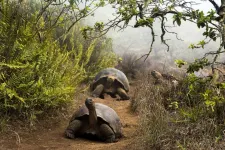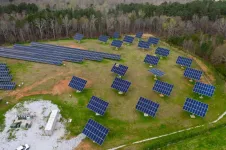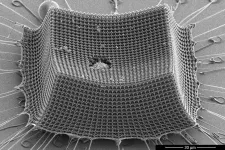Human action, key to antibiotic resistance in giant tortoises of Galapagos
2021-07-19
(Press-News.org) UCC-UCM, 13 July. The Giant Galapagos tortoises which live in contact with human farming and tourism activities, or in urbanised zones, have more bacterial resistance to antibiotics than those that live in more isolated ecosystems.
This is the main conclusion of the research published in Environmental Pollution on which Universidad Complutense de Madrid participated together with the Charles Darwin Foundation (FCD), the Institute for Conservation Medicine of the Saint Louis Zoo (ICM), the Centre for Animal Health Research (INIA-CISA) and Universidad Europea de Madrid.
Ainoa Nieto, the lead author, researcher at ICM/FCD and collaborator in practical teaching and doctoral student at UCM, explains the new information provided by the study: "Human activities are facilitating the dispersal of resistance into the environment, which has already been observed in other parts of the world, but which has never been demonstrated on the Galapagos Islands."
Resistance to antibiotics is one of the major threats to public health on the planet. The WHO has estimated that by 2050 it could be leading to more deaths than cancer, diabetes or traffic accidents. The detection of these bacteria in the Galapagos archipelago for the first time turn them into environmental pollutants and the tortoises into potential "sentinels or bioindicators" of the health of ecosystems.
PCR to identify genes and bacteria
To carry out the study, samples were taken from 270 tortoises in 2018 and 2019 in two locations with different characteristics in the Galapagos Islands: the island of Santa Cruz, which has the largest human population, and the remote volcano of Alcedo on the island Isabela.
The analyses of resistance were carried out in the INIA-CISA laboratory in Madrid using a new methodology that allows the detection of resistance genes without the need to cultivate the bacteria, through PCR reactions in real time. This technique helps identify the genes and also the number of bacteria with resistant genes that are present in a sample. In total, 21 genes were analysed that codify resistance for eight of the antibiotic families most commonly used in human and animal medicine.
"We don't know the real implications that this discovery could have for the health of giant tortoises, but resistance is considered environmental pollution, and the fact that species as iconic as Galapagos tortoises are entering into contact with these resistant bacteria implies that the ecosystem in which they live is being contaminated," explains Casilda Rodríguez, a researcher at the Department of Pharmacology and Toxicology at UCM.
Finally, Ainoa Nieto recalls that antibiotics can be bought in the Galapagos without a medical prescription, for both human and veterinarian use. The authorities do not restrict their use, as happens in Spain or other countries in the world.
INFORMATION:
[Attachments] See images for this press release:

ELSE PRESS RELEASES FROM THIS DATE:
2021-07-19
Analysis of children and young people's proximity to woodlands has shown links with better cognitive development and a lower risk of emotional and behavioural problems, in research led by UCL and Imperial College London scientists that could influence planning decisions in urban areas.
In what is believed to be one of the largest studies of its kind, researchers used longitudinal data relating to 3,568 children and teenagers, aged nine to 15 years, from 31 schools across London. This period is a key time in the development of adolescents' thinking, reasoning and understanding of the world.
The study, published in Nature Sustainability, looked at the links between different types of natural urban environments and ...
2021-07-19
When it comes to transitioning from carbon-based to renewable source energy systems, Americans are on board. They're less keen, however, having these new energy infrastructures--wind turbines or solar farms--built close to their homes, which creates hurdles for policymakers. That's according to a study from University of Georgia researcher Thomas Lawrence.
Lawrence and an international team conducted surveys in the United States, Germany and Ireland to assess people's attitudes about renewable energy technologies and their willingness to have the necessary infrastructures built nearby.
"People in Germany and Ireland were more open to having renewable ...
2021-07-19
A serendipitous flythrough of the tail of a disintegrated comet has offered scientists a unique opportunity to study these remarkable structures, in new research presented today at the National Astronomy Meeting 2021.
Comet ATLAS fragmented just before its closest approach to the Sun last year, leaving its former tail trailing through space in the form of wispy clouds of dust and charged particles. The disintegration was observed by the Hubble Space Telescope in April 2020, but more recently the ESA spacecraft Solar Orbiter has flown close to the tail remnants in the course of its ongoing mission.
This lucky ...
2021-07-19
RESEARCH TRIANGLE PARK, N.C. -- Army-funded research identified a new material that may lead to lightweight armor, protective coatings, blast shields and other impact-resistant structures.
Researchers at the U.S. Army's Institute for Soldier Nanotechnologies at the Massachusetts Institute of Technology, Caltech and ETH Zürich found that materials formed from precisely patterned nanoscale trusses are tougher than Kevlar and steel.
In experiments, the ultralight structures, called nanoarchitectured materials, absorbed the impact of microscopic projectiles accelerated to supersonic speeds.
"Increasing protection while simultaneously decreasing the weight that ...
2021-07-19
It's no secret that studies show that sexually diverse youth - in particular, lesbian, gay and bisexual (LGB) youth - use more cannabis and experience more mental health challenges than their heterosexual peers.
But what about the changes that occur in the rates of cannabis use: do they precede those related to mental health or is it the other way around? A new study from Université de Montréal offers some answers.
In the Journal of Abnormal Psychology, Kira London-Nadeau, a doctoral student and CIHR Vanier Scholar in the Department of Psychology at UdeM and the CHU Sainte-Justine Research ...
2021-07-19
Germany is not meeting its legal obligations to protect refugee women and girls from discrimination. This is the conclusion of a "shadow report" by the University of Göttingen, the association Pro Asyl and the refugee councils of Bavaria, Hesse, Lower Saxony and Saxony-Anhalt. Shadow reports are a useful tool to present important information in parallel with official government reports. Based on current research results and a survey of 65 women's counselling centres, psychosocial counselling centres and institutions working with refugees from all 16 federal states, the study finds that Germany does not adequately protect refugee women and girls and does not meet the requirements of the Istanbul Convention.
"The Istanbul Convention - also known as the Council of Europe convention ...
2021-07-19
A coronavirus related to the virus that causes Covid-19 in humans has been found in UK horseshoe bats - according to new collaborative research from the University of East Anglia, ZSL (Zoological Society of London), and Public Health England (PHE).
However, there is no evidence that this novel virus has been transmitted to humans, or that it could in future, unless it mutates.
UEA researchers collected faecal samples from more than 50 lesser horseshoe bats in Somerset, Gloucestershire and Wales and sent them for viral analysis at Public Health England.
Genome sequencing found a novel coronavirus in one of the bat samples, which the team have named 'RhGB01'.
It is the first time that a sarbecovirus ...
2021-07-19
UK policymakers preparing trade deals post-Brexit can learn important lessons from New Zealand's 'unique drug agency' the Pharmaceutical Management Agency (PHARMAC), if prices for therapies and access to key drugs are to be protected, say researchers behind a new study.
Over two decades, New Zealand has managed to reduce spending on drugs significantly and consistently despite maintaining access for its population to key treatments. As such, it is an outlier among the world's richest nations: no other OECD country has managed to achieve this.
The investigation from researchers at the universities of Bath and Durham suggest New Zealand's ...
2021-07-19
Research led by the University of Southampton into the uptake of the COVID-19 vaccine in Ghana, West Africa has concluded that vaccine hesitancy has seen a small, but significant increase over the last three months. This research is in collaboration with youth-led not-for-profit organisation PACKS Africa.
In the latest survey of 1,295 unvaccinated people, in May/June 2021, willingness to be vaccinated remained relatively high at just over 71.4 percent. However, this figure is down 11 percent on results from March 2021 when an earlier version of the same survey was conducted.
The latest findings show 28.6 percent of respondents are still either undecided or unwilling to get the jab. Among this 28.6 percent group, a little over half said ...
2021-07-19
Proteins constitute an essential dietary component that help in the growth and repair of the body. Composed of long chains of amino acids, proteins promote the growth of skeletal muscles, the group of muscles that help us move. Humans have been aware of the benefits of proteins for long. However, recent studies have shown that having the right amount of protein at the right time of the day is essential for proper growth. This is called 'Chrononutrition,' in which when you eat is as important as what and how you eat.
The reason behind this is the body's internal biological clock, called the 'circadian rhythm.' This rhythm is followed by all cells and controls life functions like metabolism and growth. Interestingly, protein digestion and absorption have been ...
LAST 30 PRESS RELEASES:
[Press-News.org] Human action, key to antibiotic resistance in giant tortoises of Galapagos





